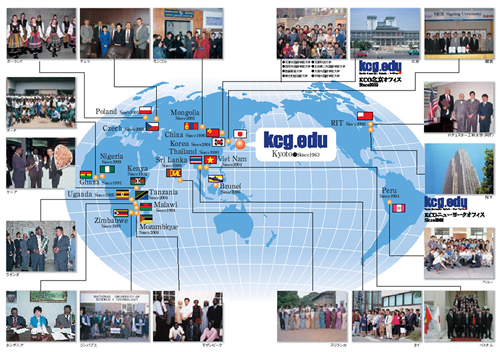

WHAT IDCE DID IN ITS EARLIER DAYS:
- Spreading Computer Education as Literacy when many parts of the world still didn't believe in it.
- Donation of Education with Recycled computers, world-wide
HOW IDCE DID IT:
- By donating a large number of recycled computers to the governments of the developing world, who then distributed the computers to public schools / organizations throughout their countries
- By offering free seminars to teachers so that they could start a computer class at their schools / organizations where they could pass on their knowledge
- By recruiting volunteer instructors to teach
WHAT IDCE ALSO DID AS A RESULT:
- Promoted Healthier Earth
- Promoted cultural exchange / friendship
BIRTH & ROOTS OF IDCE:
In the fall of 1988, the mother-daughter team of Yasuko and Yu Hasegawa (Yu Hasegawa-Johnson) initiated IDCE. In late 1989, brothers Wataru and Akira Hasegawa joined the project to make IDCE an official and unique charitable section supported by KCG. (Read more on the birth of IDCE)
The roots of IDCE lie in the history of KCG: twenty-five years earlier, in 1963, the wife-husband team of Yasuko and Shigeo Hasegawa initiated KCG, Japan's very first computer school. KCG, or Kyoto Computer Gakuin, also known as Kyoto School of Computer Science, consists of two non-profit schools and one private school. IDCE has drawn on the KCG's expertise in developing Japan's computer education. (Read more on KCG, the IDCE roots)
CONSTRUCTING METHOD:
To realize the project, we had to consider various matters. Those were:
- Circumstances of the areas that computers will be distributed (zero computers, zero computer-teachers, zero computer-textbooks)
- What was necessary to make the project most effective (corporation from the government; a large number of computers; enough funding)
- How to convince people of the importance of computer literacy education
- Who to send as instructors / how to get volunteers
- What we would teach that was most effective in each setting ( 3 Thai students invited for the trial of the seminar)
MISSION / VISION
When IDCE was first initiated in 1988 with 3,000 computers to donate, there were many countries in which public access to computer technology was limited or non-existent. IDCE was designed for such countries to give the public, at large, access to simple computers, to teach them basic computer skills, and to promote COMPUTER EDUCATION AS LITERACY.
To achieve this goal, IDCE made sure that the donation of computers would come with free instruction. The donations were made to the governments of participating countries with the obligation that the computers would be distributed to public schools / centers / libraries throughout their countries and that teachers of those institutions would be trained so that they could start classes in computer science, thus promoting basic computer education for their nations.
So far, IDCE has been implemented, in the full way or partical way, in 23 countries. According to host country impact statements from the past two decades, more than a hundred thousand rural students have benefited from the computers and training provided to their teachers by IDCE.
The donated computers have been distributed thoughout many of the receipent countries, promoting computer education as literacy.
Yasuko and Yu Hasegawa, the founders of IDCE, believed that the spread of education in science and technology was an important key to a country's future economic independence and prosperity. Keeping in mind the pioneering role of Kyoto Computer Gakuin (KCG) in developing education / information science in Japan (please read About KCG), they wished to participate in the promotion of global computer education by sharing the KCG's experiences.
In the beginning, all the donated computers had been used in classes at KCG. As to other expenses, a large part of the funding came from the Japan Exposition Commemoration Fund and major Japanese companies, such as UNISYS-Japan, TOSHIBA, NEC, and HITACHI. Other independent organizations and individuals have also contributed to the project. Without such support, IDCE would not have been able to achieve its goals.
Recently, the donated computers come not only from KCG but also from other institutions and companies.
The program also aims to promote cultural exchange and friendship between people of the world, with computer education as a medium.
IDCE also hopes to contribute to the making of a healthier earth by recycling computers.
HISTORY:
Read newspaper articles on the founding of IDCE:

